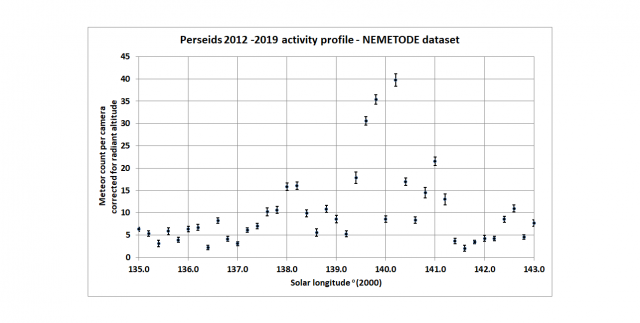- This topic has 3 replies, 2 voices, and was last updated 5 years, 4 months ago by
 Bill Ward.
Bill Ward.
-
AuthorPosts
-
10 August 2020 at 4:11 pm #574697
 Alex PrattParticipant
Alex PrattParticipantAs we approach this year’s Perseid maximum I had a look at the NEMETODE multi-year dataset to see what it could tell us about the shower’s peak activity profile.
The attached plot was derived from 8,199 observations of Perseid meteors recorded by 2 or more of our video stations. The data were corrected for radiant altitude, collated into bins of 0.2 degrees solar longitude (~4.8 hours bins) and derived a mean meteor count per camera.
The IMO describe the Perseids as displaying a broad maximum from sol. long, 139.8 deg. to 140.3 deg. (2020 Aug 12 08:15 UT to 20:45 UT) with maximum expected between 140.0 deg. and 140.1 deg. (Aug 12 13:15 UT to 15:45 UT). The IAU MDC list maximum at 140.0 deg.
The provisional plot from our multi-year results has a strong peak around sol. long. 140 deg., with a full width at half-maximum (FWHM) of at least 36 hours. (The dip at 140.0 deg. seems to be a genuine lull in our data). We’re already recording good numbers of bright Perseids, so even though maximum activity will occur during daylight from our longitude band the nights of August 11, 12 and 13 should give high rates, although the last quarter Moon will challenge visual observations and DSLR photography after midnight.
Clear skies,
Alex.Attachments:
10 August 2020 at 9:14 pm #582989 Bill WardParticipant
Bill WardParticipantHi Alex,
Super results. After the excitement of the weekend, the weather has gone downhill rapidly. Don’t think I’ll get to see much but I’ll be keeping an eye out for any breaks. Although I don’t have the recording running at the moment the I was listening to the GRAVES radar last night, some very strong pings heard.
cheers,
Bill.
11 August 2020 at 4:18 pm #582995 Alex PrattParticipant
Alex PrattParticipantThanks Bill.
Looking at the weather forecast it might be more profitable to listen to your radio system or tune in to the Radio Detection Livestream.
Cheers,
Alex.
11 August 2020 at 7:41 pm #582996 Bill WardParticipant
Bill WardParticipantHi,
I’ve had the radio on in the background for a couple of days, interesting to hear the pings vary throughout the day.
Going to head off to Dumfries and Galloway to seek out any clear skies that may develop. Going to enjoy the show and leave the technology switched off…. well except for the cameras I’ll have, just in case… ; – )
cheers,
Bill.
-
AuthorPosts
- You must be logged in to reply to this topic.
